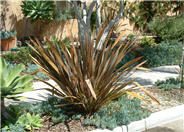
Common name:New Zealand Flax, Purple
Botanical name:Phormium tenax 'Atropurpureum'
Phormium tenax 'Atropurpureum' is an evergreen perennial. Big, dramatic plant composed of many swordlike, stiffly vertical leaves can reach 5' tall. Leaves are purple red. Flowers stems reach high above leaves, bearing clusters of 1"-2" blossoms in dark red.

Common name:Red Bunny Tails
Botanical name:Pennisetum messiacum
This clumping Pennisetum is most effectively used in mass plantings where the dark, almost black flowers can wave in the wind. Although originally thought to be an evergreen, it goes semi-dormant in most climates in Southern CA. It requires moderate water through the summer. It grows to 2' tall and 2' wide. It should be cut back annually to promote fresh growth. It should not be planted near natural areas.
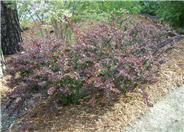
Common name:Crimson Pygmy Japanese Barberry
Botanical name:Berberis thunbergii 'Crimson Pygmy'
Pygmy purple leaf barberry is a deciduous shrub with arching branches which reaches 2 ft high and 3 ft wide. The foliage becomes bronzy red in summer and fall. 'Crimson Pygmy' prefers full sun and regular watering, more in hot summer months. This plant has thorns. It makes a great hedge. Prune in winter to re-shape.

Common name:Dwarf European Cranberry Bush
Botanical name:Viburnum opulus 'Compactum'
This deciduous shrub will grow 4'-5' tall and has dark green leaves that turn yellow, bright red, or reddish purple in the fall. Clusters of small flowers bloom in the spring followed by large red fruit.

Common name:Prostrate Rosemary
Botanical name:Rosmarinus officinalis 'Prostratus'
The 'Prostratus' grows to a height of 2'-3' with a spread to 8'. Its flowers are pale, lavender-blue in color, and the leaves are needle-like with a dark, blue-green color. This plant makes a good ground cover, and its leaves can be used as seasoning in cooking. Bloomtime is winter and spring, but also intermittently throughout the year. This ground cover like full sun and well draining soil. It is drought tolerant once it's established.
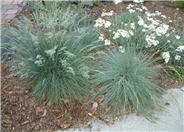
Common name:Blue Fescue, Blue Fescue Grass
Botanical name:Festuca glauca
This ground cover/grass will grow less than 1' tall and has small, blue-green, evergreen leaves that are very thin and hair-like. Flowers appear in the summer but are insignificant. This dependable ground cover prefers full sun in coastal areas and afternoon shade in warm inland areas. It needs well draining soil and is drought tolerant once it's established. Leaves may burn during the summer but trim in winter to keep it looking refreshed.
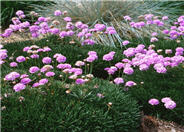
Common name:Sea Pink, Common Thrift
Botanical name:Armeria maritima
This clumping, grass-like perennial can be planted in full sun in coastal areas but needs afternoon shade in warm inland areas This CA native has small pink flowers that resemble pom poms that bloom in spring and summer. This cute flower can be used between pavers as it can tolerate light foot traffic. Overall height of plant is about 1' tall. It is drought tolerant near coastal areas but requires more water in hot summer areas.

Common name:Harry Lauder's Walking Stick, Twist
Botanical name:Corylus avellana 'Contorta'
Growing to a height of up to 8', this deciduous shrub exhibits a distinct branch structure that is gnarled and twisted.
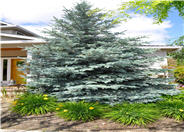
Common name:Blue Atlas Cedar
Botanical name:Cedrus atlantica 'Glauca'
As a large, slow-growing conifer, this tree requires ample room for growth. Its needles are 1" long, and its foliage (needles) is a beautiful shade of silvery blue. In order to develop its best color, the tree needs to be exposed to full sun. It can reach up to 40' tall.

Common name:Arp Rosemary
Botanical name:Rosmarinus officinalis 'Arp'
Rosemary is hardy in full sun areas where winter temperatures do not drop below 10 degrees F. They can be grown in a clay pot with well-drained, porous soil in bright indoor light, and will also flourish on the backporch in spring, summer and fall.
Its beautiful, slowly trailing stems and shiny slender leaves are perfect for showing off the small light blue flowers that blossom in the summer. -Holland WIldflower Farm
Photographer: GardenSoft
Incorporate compost 6" into your soil to retain water, reduce compaction, feed earthworms, and provide valuable nutrients to your plants.
Attract, or buy beneficial insects such as ladybugs and lacewings to control pest outbreaks in your garden.